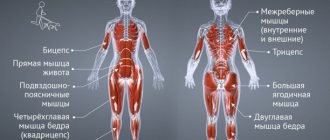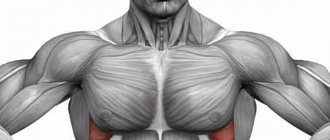Sometimes your calves may cramp during exercise. What to do in such a situation and how to prevent it? You will find out the answer in our article!
Often during training, the calf muscle cramps. Sometimes the pain is so unbearable that you have to stop training to rest and perform recovery exercises. What to do if your calf muscle cramps and how to prevent it?
A cramp is an attack of involuntary muscle contraction, which is accompanied by severe tension. According to statistics, about 75% of people suffer from leg cramps; for some, these are isolated cases, while others suffer from cramps in the calf muscles all the time. If spasms occur, you should immediately consult a doctor to determine the causes and treatment of this condition.
Why do seizures occur?
Cramps occur due to physical exertion, especially if it was sudden and too great, thermal effects (cold water), some people experience cramps even with a sudden change in weather.
Also, seizures can occur when a person undergoes any physiological changes (pregnancy, puberty, menopause). Biological changes cause changes in the levels of many substances in the blood, such as sodium, potassium, and calcium. Convulsions sometimes accompany damage to the nervous system and stress.
A change in diet can also trigger this condition; cramps are often experienced by those who abuse alcohol.
Seizures can be a manifestation of diseases such as spasmophilia, eclampsia, epilepsy, brain trauma and tumors, and inflammation.
Since seizures can be caused by serious illnesses, you should consult a doctor if this occurs.
Causes of muscle spasm
The duration of the spasm, as a rule, is up to one minute, but in some cases it lasts longer - from five to fifteen minutes. More often, this phenomenon occurs at night, when the muscle is in a relaxed state.
A sharp spasm is characterized by acute pain in the leg. The affected muscle is hard to the touch and difficult to relax by kneading and rubbing. A single cramp in the calf muscle at night occurs for the following reasons:
- uncomfortable position during sleep;
- muscle overstrain (if, for example, there was physical stress before - long walking, running, prolonged sitting, carrying heavy objects or choosing inappropriate shoes);
- dehydration;
- low mobility;
- frequent stressful situations;
- regular hypothermia of the lower extremities.
In some cases, patients turn to the doctor to find out why a cramp in the calf muscle develops so sharply and without warning at night, causing a lot of inconvenience, leaving pain in the leg in the morning.
Regular spasms can be a consequence of a number of serious diseases or occur due to a lack of certain microelements necessary for the normal functioning of the body. To understand this in more detail, we recommend that you familiarize yourself with the information in table form.
Table. Causes of calf muscle cramps at night
| Cause | Explanation |
| Vitamin D deficiency | The vitamin takes an active part in the absorption of an important microelement - calcium. The shortage is usually observed among residents of northern regions, where solar activity is low. |
| Magnesium deficiency | More often, women encounter this condition during pregnancy. The fact is that an increased dose of magnesium is required for the formation of a child. With poor nutrition, a pregnant woman develops a deficiency of the substance. The element takes an active part in the transmission of nerve impulses to cells; its lack in the expectant mother causes leg cramps. |
| Iron deficiency | The condition is called iron deficiency anemia. It has been noted that with low hemoglobin, seizures are a common occurrence. |
| Endocrine system problems | Frequent cramps may indicate a dysfunction of the thyroid gland. Thus, insufficient production of the hormones thyroxine and triiodothyronine is one of the causes of short-term convulsions. |
| Diseases of the nervous system with damage to peripheral nerves | Pathology often leads to seizures; it is important to consult a neurologist. |
| Blood pooling in the calves or toes | Excessive activity during the day promotes intense blood circulation in the vessels of the legs. However, in the evening, when the intensity of exercise decreases sharply, blood can stagnate in the area of overworked fingers or calf muscles, which actively contract during the daytime. |
| Varicose veins | Another common cause of night cramps is varicose veins. It often appears in adulthood as a result of increased stress on blood vessels or due to genetics. Leg cramps are one of the first symptoms of this disease. |
| Flat feet | This disease, gradually developing, leads to damage to the nerves and blood vessels of the legs, which causes involuntary painful muscle contractions. There is no point in delaying the treatment of flat foot syndrome. |
A cramp in the calf muscle develops suddenly at night, sparing no one: neither women, nor men, nor even children. Why does a child experience muscle cramps?
Indeed, during a period of active growth, the baby may experience spasms during sleep and, if this happens, a consultation with a pediatrician is necessary. The reasons are different: lack of potassium, calcium, congenital foot defect or hypothermia. In any case, only a doctor, based on medical examinations, will name the exact circumstances that caused the baby’s painful condition.
What to do if your calf muscle cramps?
If in the gym you feel that your leg is cramping, your actions should be aimed at improving blood circulation to the cramped muscle. Squeeze the muscle tightly and press into its central part with your index finger for 15-20 seconds. Breathe deeply while doing this.
A spasm in the lower body can be relieved by squeezing firmly (without sharp pain) the middle of the lower lip for 30 seconds.
Also, during a cramp, you can do a massage that will relax the spasmed muscle, improve blood circulation and relieve spasm.
To quickly relieve pain during a spasm, you should stretch the cramped muscle. To do this, you can use the following exercise: stand facing the wall at a distance of one step, feet slightly wider than shoulder width. Place your hands above your head and lean against the wall. Step back in small steps, keeping your feet on the floor. Step back until you feel a stretch in your calf muscles.
There should be no discomfort from stretching, so stop as soon as you start to feel pain and hold in this position for 30 seconds. To make the cramp go away faster, rub and pinch the cramped muscle.
Three ways to relieve a cramp are demonstrated in the following video by Dr. Agapkin.
What muscles are affected by this?
Theoretically, any muscle can develop a spasm. In practice, this most often occurs in the following muscles:
- Calf (located in the lower back parts of the legs);
- Quadriceps (occupy the front of the thighs);
- Pectorals (cover the chest);
- Semimembranosus and semitendinosus (back of the thighs).
It is possible that it can reduce the trapezius and sternocleidomastoid muscles of the neck and the fibers of the arms.
Muscle spasms in the feet are rare, but possible. Speaking about skeletal muscles, many people forget that the smooth muscles of internal organs, for example, the intestinal wall, blood vessels, and bronchial tree, are also susceptible to spasms. Heavy physical activity can provoke sudden contractions of such muscles and the corresponding clinical picture.
Preventing calf muscle cramps
The most important point in preventing cramps and spasms is taking special supplements and reviewing your diet. As noted above, a lack of potassium, magnesium and calcium in the body provokes seizures. All this happens because a person often does not receive the daily dose of these substances from food. For those who suffer from cramps, it is recommended to take dietary supplements or medications with magnesium. Since this element is better absorbed in the presence of calcium, you should also take calcium supplements in combination with vitamin D, which improves its absorption.
The diet should be rich in fresh fruits and herbs. It is worth eating natural sources of calcium, magnesium and potassium every day. Drinking mineral water will also benefit.
- Calcium - milk, cottage cheese, cheese, almonds
- Magnesium - buckwheat porridge, walnuts, legumes
- Potassium - dried apricots, raisins, beets, sunflower seeds, garlic.
About risk factors
Post-workout cramps cannot be controlled. However, it is necessary to try to understand what provokes their appearance. The first priority should be given to disproportionate physical activity. As a result, a signal of overvoltage is sent to the brain, and it gives a command to functional blocking. The muscle becomes so tense that its movements are almost impossible. It seems to a person that something is holding his muscles and preventing him from making free movements.
The second factor is water-salt imbalance. During exercise, the body intensively evaporates moisture, which reduces its physical endurance. In addition, electrolytes (substances that can conduct electric current) leave the body along with sweat. The most important of them include chlorine, magnesium, calcium, sodium, and potassium. Thanks to such components, electrical impulses are formed in the body, stimulating the work of the heart muscle, respiratory and nervous systems.
The third is associated with a decrease in muscle mass, for example, due to age, prolonged absence from exercise, a change in the type of sport, past illnesses, dietary restrictions, changes in living conditions.
This factor is directly related to impaired blood supply to the muscles, insufficient saturation of them with oxygen and essential nutrients. If tissues experience a lack of blood supply, they experience impaired metabolism and, consequently, the ability to convulse.
The following risks cannot be completely excluded: hypothermia, previous long-term use of medications, the presence of chronic diseases, experiencing stressful situations, severe allergic reactions, smoking and alcohol.
How to treat leg cramps
Here are some treatment tips and videos on Dr. Evdokimenko’s channel:
First, check the instructions for the medications you take daily for several months or years. Remember that many drugs (cholesterol, blood pressure, diuretics, hormones) have a side effect in the form of leg cramps. If your legs are cramping from medications, it is advisable to change the drug.
If the issue is not the side effects of medications, we begin step-by-step treatment of leg cramps:
1st stage of treatment
Magnelis B6, or Magne B6, or Magnesium-plus B6, in tablets. Buy from these drugs the one that will be cheaper. Adults take any of these drugs - 2 tablets 3 times a day, with meals, with a glass of water - for 1 month.
IMPORTANT! These medications should be discontinued immediately if symptoms of excess magnesium in the blood appear, such as: severely slow heart rate (less than 60 per minute), double vision, sudden rush of blood to the skin of the face, headache, severe decrease in blood pressure, nausea, shortness of breath, slurred speech, vomiting, weakness, severe dizziness.
All this happens infrequently when taking magnesium, however, you need to remember it.
2nd stage of treatment
If after a course of treatment with magnesium preparations the cramps in the legs have not stopped, we proceed to injections with B vitamins. Milgamma or Combilipen (which will be cheaper) - buy 10 ampoules, administer 1 ampoule (2 ml) intramuscularly to adults, every other day = that is, 10 injections.
But if 5-6 injections of Milgamma or Combilipen do not make your legs feel better, then we stop giving these injections and then move on to the 3rd stage.
3rd stage of treatment
Calcium preparations, preferably in the form of carbonate (it is believed that it is better absorbed). For example, Complivit calcium D3. Or Calcium D3 - Nycomed. We buy the one that will be cheaper. For adults take:
- Complivit calcium D3 – 1 tablet 2 times a day, preferably with meals. The tablets are chewed or swallowed whole.
- Or use Calcium D3 - Nycomed: take 1 tablet of calcium D3 - Nycomed - forte daily or 2 tablets of regular calcium D3 - Nycomed.
- The course of treatment with calcium preparations is no longer than 1 month. Check contraindications!
4th stage of treatment:
Venotonics: Detralex, Phlebodia, Diosmin, Troxevasin capsules, Troxerutin.
Exercises to treat calf cramps
Certain physical exercises help combat and also prevent calf muscle cramps. Two types of exercises are used for this:
- exercises that are performed when a cramp occurs to relieve spasm and relieve pain;
- exercises that are performed to prevent seizures and reduce the frequency of their occurrence.
If your leg is cramped, massage and muscle stretching will help relieve pain and discomfort. The following exercises are suitable for relieving spasms.
- Straighten your leg, place your foot so that the toe is turned towards the knee (for additional stretching of the cramped muscle, clasp your foot with your hands, pull the toe towards you).
- Walk on your heels for a few minutes.
- If cramps often cramp your leg, you should do exercises three times a day to prevent spasms in the calf muscle.
- Stand against a wall about half a meter away. Lean forward, extend your arms and touch the wall, while keeping your feet on the floor. Maintain this position for a few seconds and relax. Do the exercise for five minutes.
To prevent cramps, a bodybuilder just needs to eat right and take vitamin and mineral supplements. If you take all the necessary measures for prevention, but seizures still occur, be sure to consult a specialist.
Emergency (momentary) help options for leg cramps
The main advice in this situation is quite banal - try to relax as much as possible. If this does not help, then you should perform a number of actions that will help you relieve painful muscle tension:
- Straighten your legs, lift your flattened leg up, pulling your foot towards you as much as possible.
- Massage the calf muscles thoroughly, paying special attention to the most painful area of the body. During the massage, movements should be made from bottom to top, from heel to knee.
- Raise your legs and place a bolster or pillow under them. Keep your legs in this state for several minutes.
- One of the most radical methods is an injection into the cramped muscle with a pin or needle. The main thing is not to overdo it.
After you have dealt with the cramps, you should apply a warm compress to your feet or take a warm bath.
Who experiences
Most often, cramps in the legs after training occur in professional athletes, but painful discomfort can also occur in any person after increased physical activity. Usually an unpleasant symptom appears during exercise or 5-6 hours after the end of the workout.
Interesting!
The group at increased risk of cramps in the leg muscles after training are older patients. This is due to the loss of muscle mass due to a decrease in physical activity, which develops after 40 years.
Children may also complain of cramps. Their muscle pain is explained by an incompletely formed musculoskeletal system. Therefore, seizures in children are not uncommon. A third of expectant mothers also experience thigh muscle spasms. This is due to the restructuring of the body of a pregnant woman and the increased load on the lower limbs due to increased weight.
What is prohibited to do
If your leg is cramped or your leg hurts after a calf muscle cramp, it is strictly forbidden to leave the limb in the cold, as this will only worsen the condition. If a person constantly faces such a problem, it is not recommended to engage in too active sports and overload the limbs.
Preventive measures
To prevent the occurrence of cramps, special attention should be paid to the proper selection of shoes.
Doctors warn that shoes should be made only from high-quality materials and fit perfectly. In winter, shoes must be warm, since hypothermia is the first step to the occurrence of seizures.
People whose working day is spent on their feet need to do a warm-up and massage of the lower extremities every 2 hours.
First aid
Every person should know how to relieve a cramp in the calf muscle. Carrying out certain measures will shorten the time of the attack and eliminate the main symptoms of the disease.
The first aid algorithm is as follows:
- To remove a cramp in the calf, at the first sign of it, pull the toe of your foot up and straighten your toes. You will stretch the muscle and eliminate the spasm;
- You can stand on your sore leg. It is not recommended to walk, the muscle should be motionless;
- During a cramp, you can gently massage your calf - this will improve blood circulation.
In addition to the above actions, you can try to relieve the cramp by taking a warm (not hot!) bath or shower.
First aid for calf cramps











